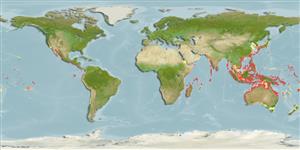Common names from other countries
Environment: milieu / climate zone / depth range / distribution range
Ecologia
marino; salmastro associati a barriera corallina; distribuzione batimetrica 5 - 40 m (Ref. 90102), usually 12 - 20 m (Ref. 27115). Tropical; 24°C - 27°C (Ref. 27115)
Western Indian Ocean: Maldives (Ref. 30829). Western Pacific.
Size / Peso / Age
Maturity: Lm ? range ? - ? cm
Max length : 12.5 cm TL maschio/sesso non determinato; (Ref. 2334)
Spine dorsali (totale) : 10; Raggi dorsali molli (totale) : 12; Spine anali: 3; Raggi anali molli: 6. Resemble C. oxycephalus but lacks spots on the tail and has a conspicuous opercular ocellus (Ref. 37816).
A common species found in rocky and coral areas of subtidal coastal reefs (Ref. 9710). Enters shallow harbors and estuaries (Ref. 48636). Solitary or in small groups (Ref 90102).
Life cycle and mating behavior
Maturities | Riproduzione | Spawnings | Egg(s) | Fecundities | Larve
Pelagic spawner (Ref. 31569). Spawning ascents into the water column occurred over a distance of 0.3 to 0.6 m (Ref. 26305).
Randall, J.E., G.R. Allen and R.C. Steene, 1990. Fishes of the Great Barrier Reef and Coral Sea. University of Hawaii Press, Honolulu, Hawaii. 506 p. (Ref. 2334)
IUCN Red List Status (Ref. 130435)
CITES (Ref. 128078)
Not Evaluated
Threat to humans
Harmless
Human uses
Pesca: pesca di sussistenza; Acquario: Commerciale
Strumenti
Special reports
Download XML
Fonti Internet
Estimates based on models
Preferred temperature (Ref.
115969): 22.4 - 28.9, mean 27.6 (based on 338 cells).
Phylogenetic diversity index (Ref.
82804): PD
50 = 0.5039 [Uniqueness, from 0.5 = low to 2.0 = high].
Bayesian length-weight: a=0.01585 (0.00637 - 0.03944), b=3.01 (2.79 - 3.23), in cm Total Length, based on LWR estimates for this (Sub)family-body shape (Ref.
93245).
Trophic level (Ref.
69278): 3.5 ±0.55 se; based on food items.
Fishing Vulnerability (Ref.
59153): Low vulnerability (10 of 100).
